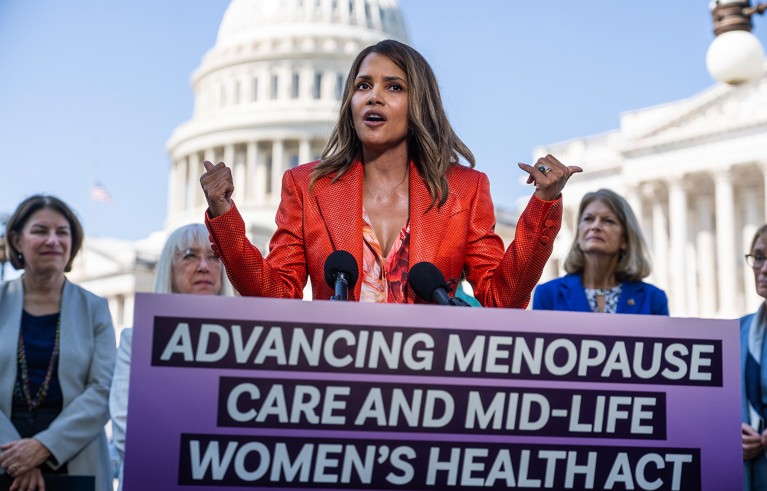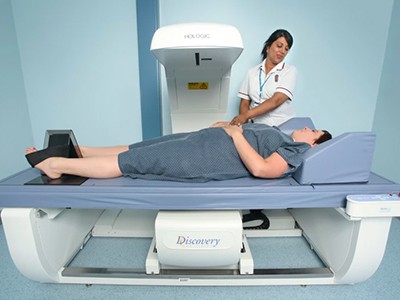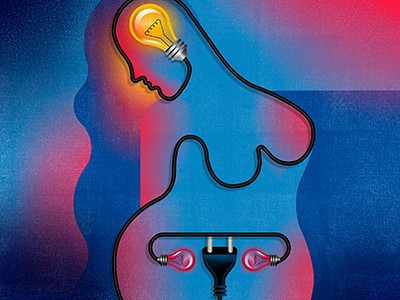In late 2022, Naomi Busch, a lone physician in her book group, began fielding question after question about menopause. Members of the group had started to experience the hallmark symptoms — hot flushes, poor sleep and mood swings — and wondered what they could do about them. “They all looked at me,” says Busch, “and I was like, ‘I don’t know anything about menopause.’” She searched for knowledgeable physicians in and around Seattle, where she lives, but the few specialists were booked out for several months. Meanwhile, the women in the book group were not getting the answers that they needed from their gynaecologists or primary-care physicians. “I’m not going down quietly,” Busch remembers one woman vowing.
Busch, who trained in and practised primary-care medicine, wasn’t surprised by the lack of information. “It’s not something we learn about in medical school,” she says. So Busch decided to find out everything she could about menopause. Ultimately, she passed a competency exam to become a certified practitioner through The Menopause Society, a non-profit organization based in Pepper Pike, Ohio, that provides tools and resources to health-care professionals. She’s not alone in her interest. More than 1,300 providers became certified in 2024; and more than five times as many people applied for the exam in 2024 as in 2022. The International Menopause Society, a UK-based charity, also offers a free online training programme for health-care professionals. More than 2,600 people completed the course in 2024, up from under 2,000 in 2023.
Menopause research is globally underfunded. It’s time to change that
Many health-care professionals — along with society in general — regularly tell women, and transgender, non-binary and intersex people who go through menopause, to accept the misery of the transition, and the health troubles that can follow. Menopause comes with increased risks of health conditions such as cardiovascular disease, diabetes, osteoporosis and memory loss.
Yet, few medical options are typically presented to people going through menopause. Sometimes, oral contraceptives are prescribed to ease symptoms and prevent unwanted pregnancies, which are still possible during the transition. But common doses and formulations can include risks, such as developing blood clots, and don’t always provide sufficient treatment, says Busch. Non-hormonal drugs, such as fezolinetant and elinzanetant, treat hot flushes — but they also have side effects. Other options include antidepressants, cognitive behavioural therapy, acupuncture and lifestyle changes, which usually go only so far in alleviating symptoms. Hormone replacement therapy, which was a routine treatment until 2002, is widely passed over, owing to a misinterpreted study1 that prompted fear of its use.
The outlook for managing menopause is now starting to change, say researchers and clinicians. Treatments — both old and emerging — are offering hope. Some researchers, for example, are revisiting hormone therapy and the optimal time for treatment to start. Others are exploring the benefits of stalling the onset of menopause
After decades of neglect, research funding for menopause, as well as public awareness, are now on the rise. This is a notable step in what advocates hope could be a revolution in women’s health. In May 2024, the US National Institutes of Health held a round table on future directions in menopause research, and through a White House Initiative that year, the administration of then-president Joe Biden awarded US$113 million to women’s health research. Meanwhile, a groundswell of vocal advocates around the world continue to push for awareness of how menopause affects health. Actor Halle Berry has joined US senators in championing a bill that would boost menopause research; a UK-based group of women called Menopause Mandate has organized walks to raise awareness; and Menopause Solutions Africa offers workplace training programmes.
It’s hard to imagine a therapeutic space that would have as much potential payoff, specialists say. Menopause affects half the population, and it interrupts a time when people are in their prime professionally.
Replenishing hormones
“There is renewed interest in menopause right now, and we need to take advantage,” says Stephanie Faubion, the director of Mayo Clinic’s Center for Women’s Health in Jacksonville, Florida, and medical director of The Menopause Society.
For decades, what researchers are now pushing to call ‘menopausal hormone therapy’ was the gold standard of care for alleviating common symptoms of the menopause transition. Menopause occurs when the ovaries’ last eggs are depleted. Practically, it’s defined as having had no period for 12 months in a row. Although menopause can be induced by surgery or medical treatment, for most people, it happens naturally during midlife — typically between ages 45 and 55. It’s preceded by perimenopause, a period of about four to eight years when the ovaries slow their production of certain reproductive hormones. This can result in erratic fluctuations in hormone levels, launching a rollercoaster of symptoms that can continue into the postmenopausal years. Hormone therapy replenishes some of those depleted hormones, particularly oestrogen and progesterone, and so smooths out that ride. What’s more, it can stave off osteoporosis and might provide other long-term health benefits.
Women’s health research lacks funding — these charts show how
But the popularity of hormone therapy plummeted in 2002 with the publication of an initial report1 from a long-term US study called the Women’s Health Initiative (WHI). Early analyses found that people who had been through menopause and who were taking oestrogen and progestin (a synthetic form of progesterone) had slightly increased risks of breast cancer, heart attack and stroke. In its wake, the number of prescriptions for postmenopausal hormone therapy dropped abruptly worldwide. In the United States, estimated rates fell from as high as 40% down to below 5%. Susan Davis, director of the Women’s Health Research Program at Monash University in Melbourne, Australia, says global rates similarly slumped.
Subsequent work highlighted the substantial limitations and misinterpretation of the findings; data from subsets of participants in the WHI and other trials even revealed contradictory findings, including lowered risk of heart disease and death associated with hormone therapy, and decreased rates of breast cancer for those taking oestrogen-only therapy. Scientists have been trying to set the record straight since.
Finally, in May 2024, a review2 gained traction in medical circles and the popular media. The authors, many of whom worked on the original 2002 paper, re-emphasized that the hormone formulation, dosage and route of delivery in the WHI trials differed from what is typically used today. For example, the therapy was taken only orally in the trials. Today, the use of transdermal patches can reduce concerns about the blood clots that can be associated with oral delivery. A recent shift to hormones that are identical to the ones the body makes and the prescription of lower doses of hormones might further reduce risks, the authors note. Researchers point to another important issue: most of the people enrolled in the WHI trials were at least a decade into their postmenopausal years. At that point, research suggests, the sudden renewed presence of oestrogen might cause health problems. In other words, the timing of hormone-therapy initiation might matter.

Actor Halle Berry advocates for US legislation that would increase menopause research.Credit: Tom Williams/CQ-Roll Call, Inc/Getty
And beyond managing menopause symptoms, there are long-term benefits that could outweigh any risks. Data since the late 1980s solidly back the use of menopausal hormone therapy to prevent osteoporosis in all age groups. “The big thing that was missed in this whole WHI story was the benefit of oestrogen for fracture,” says Davis. She has been investigating whether supplemental testosterone could also protect bones after menopause.
For heart disease, the equation gets more complicated. If the therapy is started early, evidence suggests that it might prevent vascular disease. But, in people with vascular disease, researchers say, the therapy might worsen the condition. There are also emerging hints that well-timed therapy can benefit brain health.
At present, the exact benefits and risks of the therapy remain unclear, says Davis. “Depending on how you slice and dice and cherry pick the data, I could give you any story you want to hear.” Her concern is that researchers continue to trawl big data sets without understanding the nuances and limitations of the data.
Prolonging ovarian life
Guidance for menopause management around the world remains controversial, inconsistent and changes rapidly, specialists say. Still, there is growing consensus that clinicians should “very seriously consider” hormone therapy for women within ten years of reaching menopause, or before age 60, if they have no contraindications, says JoAnn Manson, a women’s health researcher at Harvard Medical School in Boston, Massachusetts. Although more research is needed, she says that early-initiated hormone therapy might be safe and beneficial to take long term. A study3 co-authored by Davis even suggests that the benefits of initiating hormone therapy later in menopause might still outweigh the risks.
How menopause reshapes the brain
Wearable sensors, as well as implantable bioelectronic devices, could help to identify the optimal window for starting hormone therapy by tracking hormone levels in real time. Some physicians caution against using the therapy during perimenopause because of the potential for high combined hormone levels during erratic natural fluctuations. One day, these devices might even dispense hormones on an as-needed basis.
Still, some specialists point out, replacing hormones might not be enough. The ovaries are responsible for more than making oestrogen, progesterone and eggs. The small organs send chemical signals throughout the body, driving “hundreds of other factors with health benefits”, says Zev Williams, a reproductive endocrinologist at Columbia University in New York.
When the ovaries fail, says Renee Wegrzyn, director of the Advanced Research Projects Agency for Health (ARPA-H), a government agency tasked with steering the White House Initiative on women’s health, “there are a lot of chronic health conditions associated with that”. So some scientists have a different idea — keep the ovaries working indefinitely.





